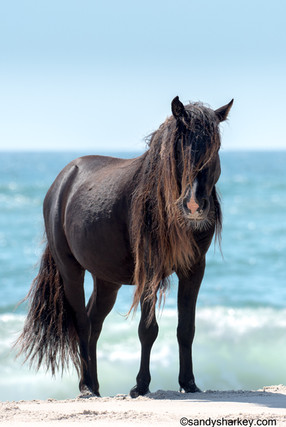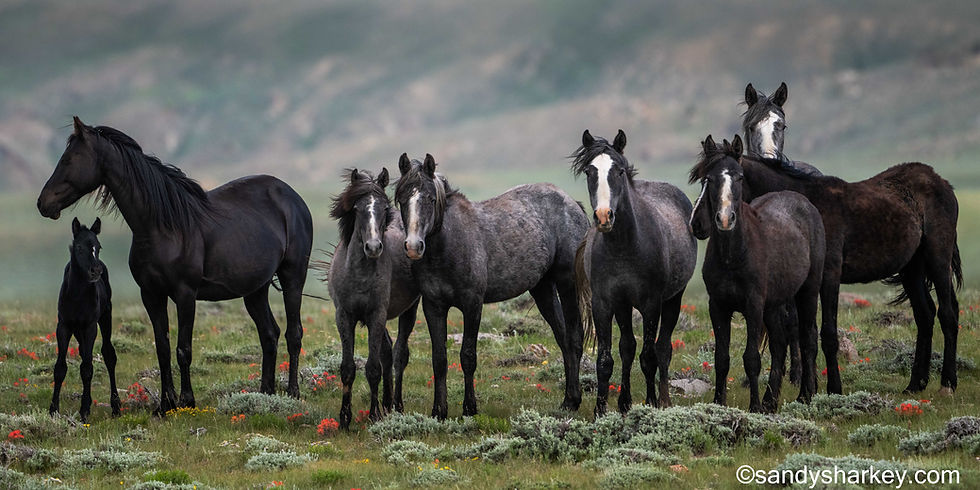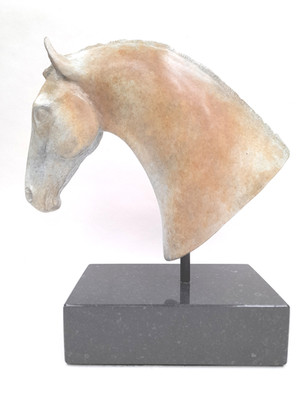- Robin Black

- Sep 9
- 7 min read
EquuStyle: When did you first become interested in photographing wild horses? What sparked that passion for you?
Sandy Sharkey: In my early twenties, I was on a trail ride in Alberta’s Rocky Mountains near Banff. One afternoon, I was lying on my back in an alpine meadow, my trail horse contentedly munching grass beside me. Suddenly, everything shook- and I jumped up, convinced that I was experiencing an earthquake. It wasn’t an earthquake. It was a herd of wild horses, galloping past me on a rocky ridge. It was over as quickly as it began- and the wild horses disappeared into a forest. But it was one of the most beautiful things I’d ever seen.
At that time, I had no idea that wild horses existed. My life was forever changed. I needed to experience wild horses again and again, to capture their essence with my camera, and to share their stories of free spirited resilience.
EquuStyle: What personal connection do you feel to the wild horses you photograph, and how does this influence your work?
Sandy Sharkey: I think the most ‘free spirited’ time of our lives, is when we are kids- before the wide ranging demands of society take root. Over time, that free spirit of youth is diminished under the weight of responsibility. When I’m with wild horses, I feel like that 8 year old kid again. Wild horses are symbolic of freedom, embodying an unabashed free spirit that exists in all of us.
In many ways, connecting with wild horses can reconnect the adventurous soul that we’ve buried through adulthood. Someone once told me, ‘it’s not how you feel about someone, it’s how you feel about yourself when you’re with that person’. The same applies to wild horses. When I’m with these magnificent animals, the awakening of my heart and soul influences my photographic work in a visceral way.
If one of my images captures the free spirit of a wild horse, creating a beautiful connection between human and horse- this is much more important to me than a technically perfect photo.
EquuStyle: Could you share a memorable encounter with a wild horse that deeply impacted you?
Sandy Sharkey: There are so many to choose from. But one encounter stands out. In the spring of 2018, I was photographing wild horses in Utah’s Onaqui range. One morning, I saw this huge cloud of dust rolling across the desert floor like a scene from ‘Wile E. Coyote and the Roadrunner’. The trail of dust was created by one scrappy, smallish wild buckskin stallion known as ‘Buck’. He was covered in battle scars and several wounds were fresh, but nothing stopped him. Buck was determined to steal the mares from every stallion in sight.
He wasn’t successful that day, and I’m not sure that he was ever successful, but the huge spirit from this small package embodied persistence, true grit, and wild spirit; everything we love about wild horses. Buck is my horse hero.
EquuStyle: What initially drew you into wild horse advocacy?
Sandy Sharkey: When I first started photographing wild horses, it wasn’t long before I began to learn about the challenges they face. I couldn’t continue to share photos of beautiful wild horses without speaking out and raising awareness about the atrocities of wild horse roundups and the slaughter pipeline.
Along with photographic storytelling, I began to host wild horse retreats and trips to other wild horse areas in the world. When we see mankind’s treatment of wild horses, and how it differs depending on geographic location, we can better understand and help shape a future where wild horses are protected and respected.
In the American west, thousands of mustangs have been rounded up by helicopters and removed by the U.S. government, in deference to the demands of public lands ranchers. The system is broken and the government is resistant to working for meaningful change.
There are over 60,000 wild horses languishing in holding facilities. In contrast, cattle ranchers in northern Portugal are accepting of the ‘Garrano’ wild horses. In Chilean Patagonia, wild horses known as ‘Baguales’ are also revered, and have become a draw for adventurers. In Mongolia, Przewalski’s horses were extinct from the wild, but due to a successful captive breeding program, they once again roam the Mongolian steppes.
The wild horses of Canada’s remote Sable Island are 100 percent protected, living wild and free with zero interference from mankind. We have much to learn regarding mankind’s complex relationships with wild horses.
EquuStyle: How do you believe your images help to shift perceptions and garner support for wild horses?
Sandy Sharkey: My goal on social media is to have my wild horse images pack a one-two punch. Hopefully someone is emotionally drawn into a photo, whether it’s a wild horse portrait, a wild horse family band or an action shot- and they stick around long enough to read the text that goes along with it.
My posts can include hard-hitting calls to action- or they can be sweet or humorous. I try to mix it up as much as possible, because different people respond to different things.
EquuStyle: What are some of the biggest misconceptions about wild horses that you aim to dispel through your advocacy?
Sandy Sharkey: Wild horses are sentient, intelligent, family oriented animals that have earned the right to exist peacefully on the landscape. Those who profit from usage of public lands have created a false narrative about wild horses being a strain on the ecosystem. Nothing could be further from the truth.
Unfortunately the wild horse has become the scapegoat for rangeland damage caused by human activities, particularly public lands ranching. My wild horse advocacy is rooted in dispelling the false narrative wrongly promoted by special interest groups.
EquuStyle: As a speaker, when addressing audiences, what are the key messages you strive to convey about wild horses?
Sandy Sharkey: It starts with instilling the knowledge that wild horses actually EXIST. I shouldn’t be surprised that most people don’t know that wild horses live in wild spaces around the world. I had no idea myself- until that eye opening encounter in the Alberta wilderness so many years ago.
As a speaker, I always begin by assuming that I’m introducing the wonder of wild horses to someone for the first time. Following that, my role is to convey wild horses’ precarious relationships with humans, and how we can work together to elicit positive change.
EquuStyle: How do you engage and inspire individuals who may have little prior knowledge or connection to these animals?
Sandy Sharkey: I try to engage people in a way that they can relate. Storytelling is immensely important. For example, to wild horses, family is everything. When wild horse families are ripped apart by tragic helicopter roundups, the stallions, mares and foals desperately call out to each other after being indiscriminately packed into livestock trailers and separated forever. We can’t begin to imagine the heartbreak. But we can certainly relate to our own family relationships, and reflect on the tragedy of being separated from a loved one.
EquuStyle: Do you have a story about how your images of wild horses or a speaking engagement directly impacted wild horse conservation or policy?
Sandy Sharkey: In 2023, I was honored to speak at the Wild Horse Conference in Washington DC. My presentation was titled ‘Storytelling for Change’. Stories connect us all, and it’s the most powerful way to invoke positive change.
To help save wild horses, it’s important for people to have an emotional connection. Strong storytelling can move mountains. I love grassroots campaigns powered by the human heart. I created the hashtag ‘#ButImJustOnePersonSaid300MillionPeople’ to encourage people to listen to wild horse stories and feel moved to act. Every single voice is a megaphone.
EquuStyle: Who are some individuals who have inspired you in your journey as a photographer and advocate?
Sandy Sharkey: There are far too many to mention, and I would likely miss someone! Over the years I’ve been fortunate to work with outstanding people who have dedicated their lives to wild horses. I’ve stood shoulder-to-shoulder on wild horse ranges with advocates that know the herds and the individual horses, from birth to adulthood to death from old age (it’s always a unique gift when a horse lives wild and free for his/her entire life, which speaks volumes about the high odds of being captured long before that day).
I’m inspired by the photographers, the writers, the organizers of webinars and rallies, the creators of film and music, and everyone who works tirelessly to ensure that wild horses will run free for generations to come. And to the members of the public who don’t look the other way- taking the time to make phone calls, write letters and share posts. In many ways, they are my greatest source of inspiration.
EquuStyle: What inspired you to guide photography tours of wild horses on Sable Island?
Sandy Sharkey: I want the world to know that a place actually exists, where wild horses are 100 percent protected. Located 180 miles from Halifax Nova Scotia in the Atlantic Ocean, the grassy dunes of Sable Island are home to approximately 500 wild horses. Here, they are free to form family bands, give birth, watch their foals grow, and share lifelong bonds with each other, with zero interference from mankind. The horses are managed by mother nature, living an existence in harmony with the sea.
Being on Sable Island not only feeds our soul, it restores our hope that one day, all wild horses will be as revered and respected as the wild horses that have survived on this crescent-shaped island for over 350 years. We must never give up hope.
EquuStyle: For those interested in supporting wild horse protection, what concrete actions would you recommend they take?
Sandy Sharkey: It’s a good idea to follow wild horse organizations that provide excellent background information, along with current news and suggested calls to action. Here are some respected sources:
It’s important to contact your legislators and ask for humane reform regarding the treatment of wild horses. Elected officials can’t ignore an army of voices.
And while the fight to save wild horses is in the category of ‘David vs Goliath’, I prefer to look at it this way: WE are not David, WE are Goliath. Thankfully, those with empathy and compassion greatly outnumber those who profit from public lands and want the wild horses eliminated. We just need to stay together and raise our voices.
Remember: #ButI’mJustOnePersonSaid300MillionPeople
All images Copyright Sandy Sharkey Photography-all rights reserved. Cannot be reproduced for any purpose without permission from Sandy Sharkey and Sandy Sharkey Photography.



















































